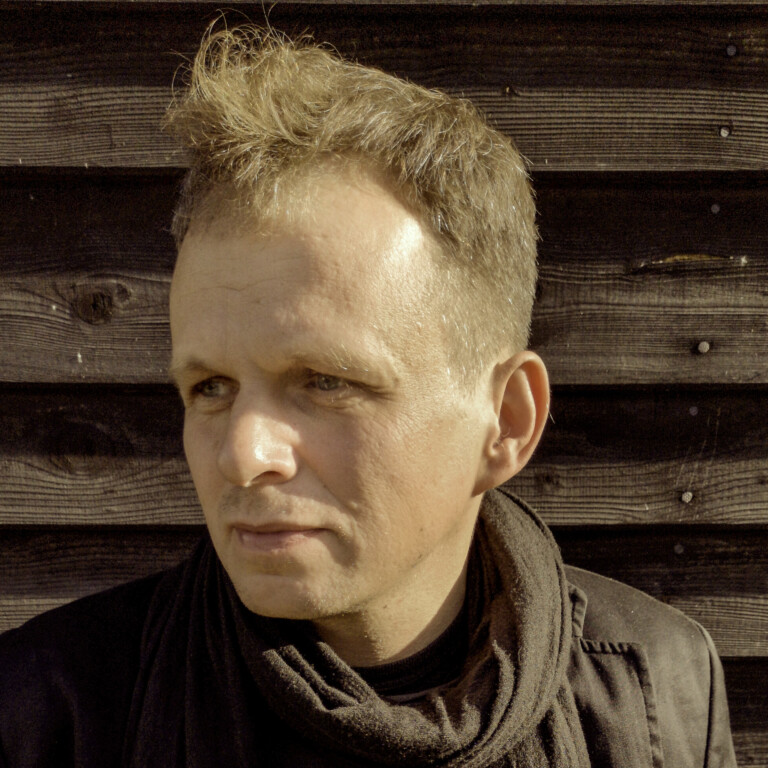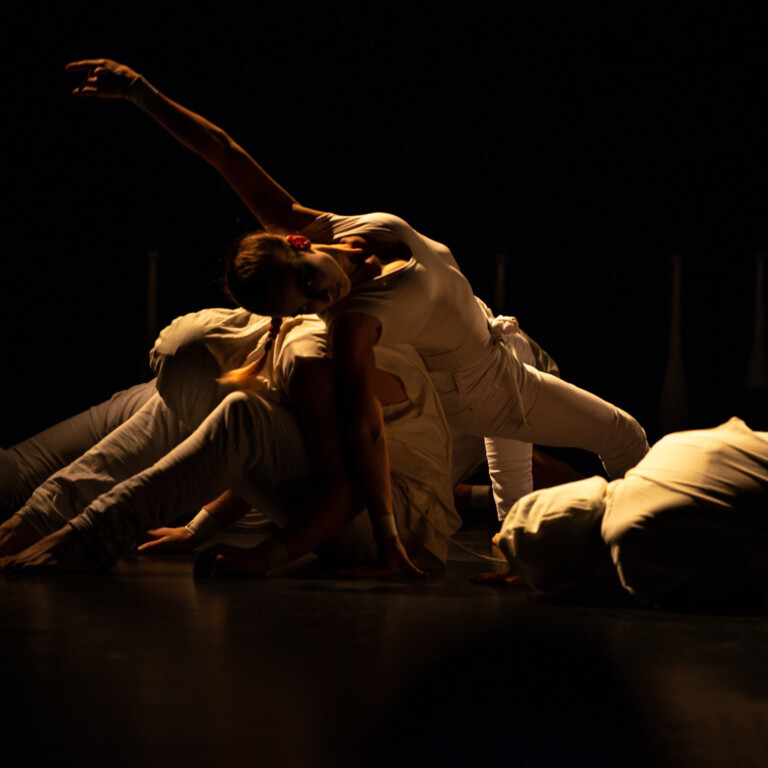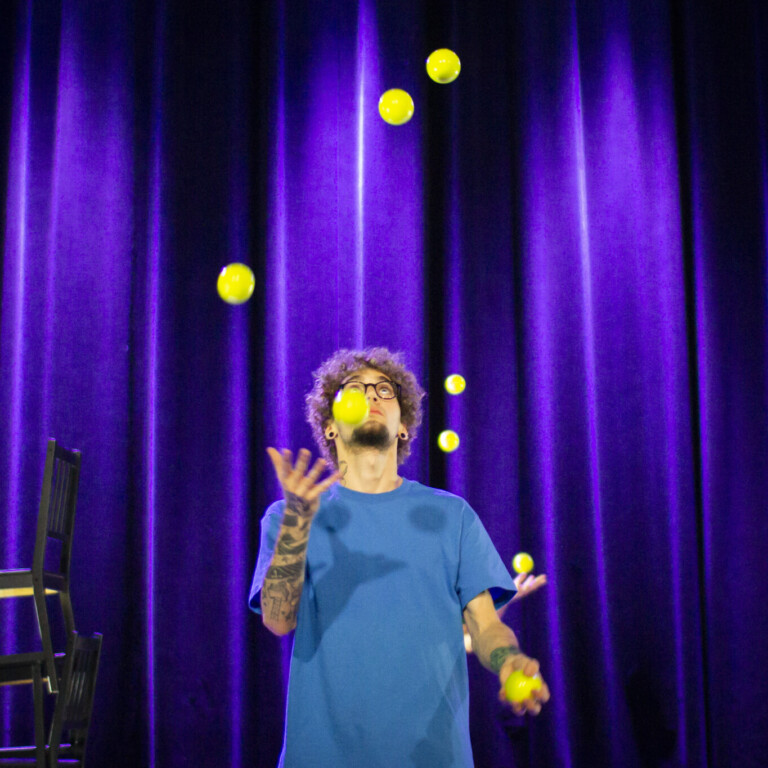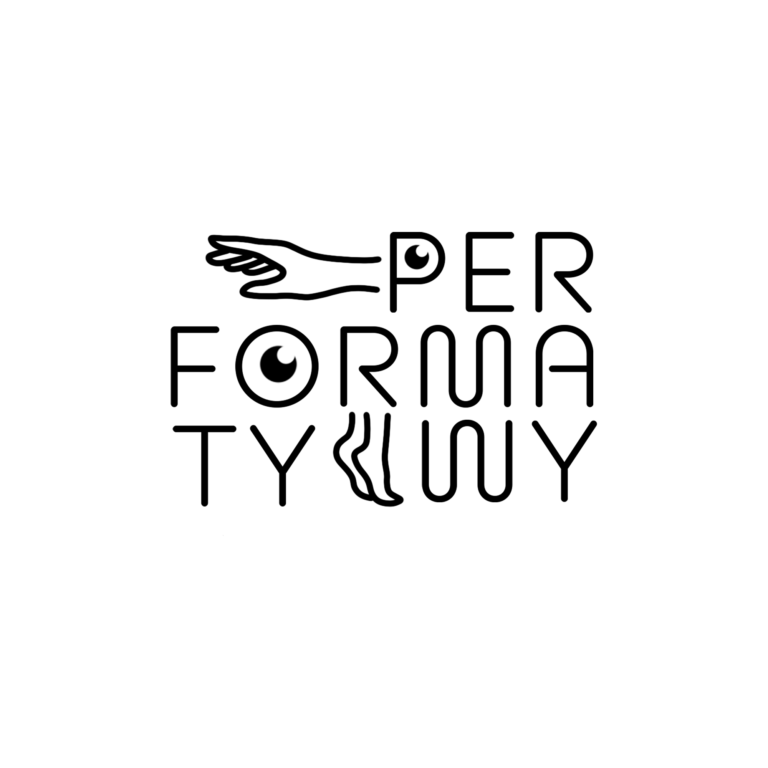The practice of circus has always been firmly rooted in the physical and the pragmatic. However, there is a growing recognition that engagement with critical reflection and discourse is also invaluable to the healthy ongoing development of the field. This essay is a contribution to that discourse, offering some new vocabularies for analysis of circus performance that can expand our possibilities for in depth discussion of forms and approaches. The focus is on those varieties of circus practice that are composed specifically for an audience to experience, whilst recognising that the field also encompasses other types of practice, such as recreational, technical or social circus, which are often neglected from the dominant conversations emerging from academic and policy-focused circus studies.
This essay follows and expands upon a talk presented in October 2024 at the first of Sztuka Cyrku’s ‘Circus Today’ seminars on Aesthetics, Politics and Technology. It draws upon doctoral research conducted at Cardiff University over the last five years1, as well as ongoing conversations and engagement with the circus sector for over a decade as an independent writer and researcher. In particular, it addresses one of the challenges in articulating different approaches to – and varieties of – circus performance that are not adequately accounted for within the conventional labels of ‘traditional’, ‘new’ and ‘contemporary’ circus.
A report published by the European Commission in 2020 acknowledged that these labels rely heavily on personal interpretation, with no widely accepted definition of their distinction2. While they can provide a vague shorthand for broad swathes of style or history, they do not serve us well when we try to analyse the content of different productions more closely. As scholar Franziska Trapp has recently commented, attempting to categorise circus using these conventional labels presents a “great difficulty… due to the various techniques but also the performance contexts.”3
The ability to analyse and articulate different types of circus performance is not just an academic exercise. It has real world implications for creators, promoters and audiences. Research has illustrated that audience member experiences must tally with their expectations and preconceptions in order for them to have a satisfactory encounter with a production4, leading to return custom. This means that circus shows need to be promoted in a way that clearly communicates what a potential audience member can expect. The fuzziness of the conventional ‘traditional’/’new’/’contemporary’ labelling does not adequately allow for this.
At the other end of the chain, when creators are first making work, the ability to articulate thoughts and intentions clearly among collaborators and partners is also extremely valuable. Access to more precise vocabulary during the making can result in more focused processes and a more cohesive final product. Similarly, the ability to communicate clearly with venues and bookers makes sure everybody is on the same page with what sort of work is expected, avoiding some potential pitfalls of misunderstanding or disappointment.
My PhD research adopts a model of categorisation adapted from the structures of Systemic Functional Linguistics (SFL). This is an extensive system, originally used to describe the communicative functions of language, but since adapted to generate insights into the communication of other forms, such as advertising images, body language, films and dance. As a circus production is another form of communicative event between artists and audience members, it is a pertinent model to explore.
At the heart of SFL classification lie three metafunctions, which co-exist in any communicative event: the Ideational metafunction, which relates to the concepts, ideas and ‘aboutness’ of the communication; the Textual metafunction, which relates to the composition of content within the communication; and the Interpersonal metafunction, which relates to the alignment between the producer of the communication and their anticipated audience. Within a circus performance context, these can be reframed through more specific terms: within the Ideational function, we can talk of Narrativity – is a concept communicated overtly through storytelling? Do variations on a theme suggest a more amorphous concept? Does the performance avoid concepts altogether, generating meaning primarily through embodied response? In these cases, we can apply the labels of Storytelling, Thematic, or Non-Narrative as appropriate.
Within the Textual function, we can talk of Integration. This relates to how the physical, visual, and technical elements of a production are composed – do the different elements converge towards a single Ideational experience? Do the various elements sit in parallel, providing alternate Ideational experiences? Here, we can apply the labels of Interwoven or Layered respectively.
Within the Interpersonal function, we can talk of Dramaturgical Driver. This relates to the main form of attention required from an audience member, manifesting as affect – while watching, does it make me follow a thought? Does it make my body feel things? Does it make me consider the spectacle? In these cases, we can use the labels Cognitive, Visceral, or Aesthetic respectively. My research has found that affective experience is of significant value for audience members, and so an understanding of this function can be particularly key in communicating the nature of a production.
In 2022, Jarkko Lehmus, Director of Finland’s centre for development and promotion of circus – Cirko – gave a speech at Subcase industry showcase that reflected this need for an understanding of affect: “there’s no use in categorising a performance as entertainment or art. What can be useful is looking at what that performance does. Does it amuse you, make you feel like crying, transport you away to another world, convulse you with disgust or perhaps raise thoughts about an unspoken societal issue?”5
He goes on to call for circus that affects him on a physical, emotional and intellectual level. In these terms, the physical experience he desires can be found through a Visceral driver, and the intellectual can be experienced through a Cognitive driver, but the Aesthetic driver – affecting an experience of beauty via sensory stimuli – is not touched on. All three of these drivers have the power to create an emotional affect, but the Aesthetic is often overlooked in description and discussion of circus. While none of the classifications in this analysis model are inherently more or less desirable than any other, it’s the lack of attention to Aesthetic driven work that prompts the particular focus for the rest of this essay.
Perhaps one of the reasons that aesthetic experiences are less prominent in discussions of circus work is that they are less prominent in the work being presented than cognitive or visceral experiences are. Of the 114 productions that formed the basis of my study6, just 14% were identified as Aesthetically driven, compared to 44% Cognitive and 42% Visceral7. Whilst I can list examples, it is perhaps more useful to speak in general terms of how this less common form of circus experience manifests phenomenologically.
I categorise a performance as aesthetically driven when I find myself engaging through a kind of ‘art gallery mode’ of viewing. I have a relaxed sort of attention – I can look away, or get distracted and then zone back in without having lost anything crucial. I feel contemplative, even meditative or ritualistic (although a sense of ritual can also veer more into a Visceral zone). I’m absorbed in sensory input; it washes over me, creating a particular ambience that is based on my appreciation of the sensory stimuli rather than on thinking or on any direct physiological reaction or response.
Published reviews of aesthetically driven productions can draw upon this sensory experience, as in the following examples:
“Jack Wrigley’s lasers split the ceiling in rippling primary colours, both psychedelic retro and future- facing. Red splodges of light pick out the curves of, and respond to the movement of Aedin Walsh’s suspended body. Wisps of colourful cloud illuminate the atmosphere: sometimes jarring; sometimes meditative.”8
“Beautifully lit from the side (the lighting design throughout is super), and with lasers shooting across the stage, it’s a real sight to behold.”9
“a show whose visual effect is simply overwhelming.”10
“At the heart of Spring is also the choreography’s relationship to music and to light. The score by Gabriel Prokofiev – which fuses live drumming, a string ensemble (Camerata Alma Viva), and electronic music) – is the driving force of the piece, catapulting the performers and objects through the space. It is both relentless and enticing, so much so that the moments of silence land as clear punctuations in the work…There are also moments of respite in Guy Hoare’s lighting score, which is guided by a similar depth and intensity.”11
The final excerpt cited above comes from a review of the Gandini Juggling show Spring, a collaboration with choreographer Alexander Whitley. Another review of the same production seems to hit upon a pertinent point while describing the “joyful exercises in colour, shape, rhythm and sound…. The brain likes pattern and order. It fires up our pleasure centres in a deeply ingrained response.”12
It is this ingrained response to patterns and gradations of sensory stimuli that triggers a classification of aesthetically driven work. Naturally, this type of analysis has a highly subjective nature. The notion of Aesthetic experience as a Dramaturgical Driver also calls into question the home of that subjectivity. The term dramaturgy is usually used to refer to processes of creation; to the intent of artists rather than to processes of reception and the experience of audience members. Might the dramaturgical driver as experienced by an audience member differ to that which was intended by the creators?
The second review cited above refers to Gravity & Other Myths’ production Backbone. Whilst I – and, it appears, this reviewer – found the Aesthetic drive to be most prominent, it’s easy to imagine another viewer who might find themselves experiencing a more Visceral form of attention13. Other audience members may find themselves focusing on semiotics and interpretation, indicating a focus on the Cognitive drive – particularly those people more familiar with theatre audiencing practices than circus performance. I think it is often this gap between theatrical, cognitive ways of viewing and the more visceral and aesthetic potentials of circus meaning that causes many reviews of circus performance to fall short of really ‘getting it’, something artists report time and time again14.
Perhaps a measure of success, then, is a coming together or matching of the artists’ intent and their audience members’ experiences? Or perhaps it is more like the Indian concept of rasa, wherein success is achieved if the author puts their own experience of beauty in to a work, and the audience experience their own beauty from it in turn, producing a oneness that does not need to be identical in nature? In which case the Dramaturgical Driver going into the creation of a work need not tally with the Dramaturgical Driver as experienced by its various audience members.
These are questions that need further attention, as indeed does the more particular notion of Aesthetic experience as a Dramaturgical Driver, whether through reception or design. What we do know, however, is that conventional modes of loosely defining circus types are inadequate for detailed analysis of production types. Analytical frameworks that currently exist tend to focus on the production as a stand-alone object, not as a subjectively experienced engagement; the Interpersonal function of circus communication is currently under-researched.
It’s also valuable to highlight that the model of classification adopted here allows for analysis to be conducted at micro and macro levels. So, whereas I have focused my research to date on entire productions, it is also possible to consider the communicative structure of particular scenes, acts or numbers, or even individual movement sequences. Or, at the other end of the scale, one could consider an artist, company or venue’s entire repertoire rather than looking at singular productions.
There is considerable scope for further development of this analytic framework, so I hope it proves useful ground for fruitful conversation and debate. Importantly, the suggestions contained in this essay are offered for people to experiment with in their own articulations of circus work. The goal of this essay has been to provide some new vocabulary to circus friends and practitioners, to expand the potential for a richer and more valuable discourse on types of circus performance. If you’d be interested in discussing these ideas further, please do get in touch, and I look forward to hearing any thoughts or opinions on the subject.
This article was made possible thanks to a subsidy from the EU under Poland’s National Recovery and Resilience Plan.
- Funded by the Economic and Social Research Council, UKRI
- European Commission, Directorate-General for Education Youth Sport and Culture, Vroonhof, P., Clarke, M., Goes, M., Panteia & Snijders, J. 2020. The situation of circus in the EU member states. Luxembourg: Publications Office.
- Trapp, F. 2024. Readings of contemporary circus: A dramaturgy, London, Routledge. p.252-253
- Conner, L. 2013. Audience engagement and the role of arts talk in the digital era, New York, Palgrave MacMillan.
- https://cirko.fi/en/call-out-for-the-circus-2/
- All identified productions presented in the UK between Feb 2019 and Jan 2020
- The Aesthetic drive appears most often with a Narrative structure categorised as Thematic (89%), but all combinations are represented in the identified productions, with the exception of Non-Narrative|Layered|Aesthetic. This sort of performance could perhaps be seen instead within competition environments, akin to the acrobatic presentation of rhythmic gymnastic displays.
- https://thetempohouse.wordpress.com/2018/05/28/review-liquid-sky-tramway/
- https://www.scotsman.com/arts-and-culture/edinburgh-festivals/dance-physical-theatre-and-circus-backbone-underbelly-bristo-square-1410789
- https://www.theatrereviewsnorth.com/post/circa-humans
- http://totaltheatre.org.uk/gandini-juggling-alexander-whitley-dance-spring/
- https://www.theguardian.com/stage/2019/feb/01/gandini-juggling-alexander-whitley-spring-review-sadlers-wells
- Although I suspect that the sheer volume and consistency of exceptionally high level acrobatics featured would have the effect of reducing an initial visceral experience as the show progresses.
- See e.g. Kavanagh, K. 2019. Criticism within the circus sector: Redressing a power imbalance. Platform, 13, 64-85. This does not discount the work done specifically on circus semiotics, notably by Paul Bouissac and Franziska Trapp.















